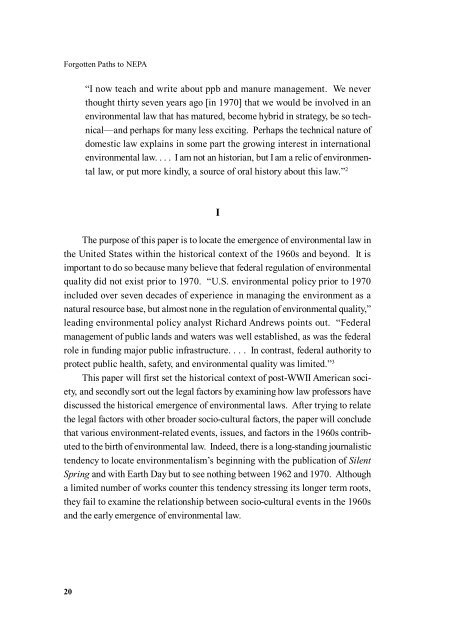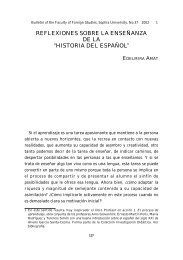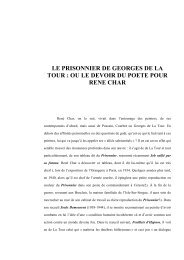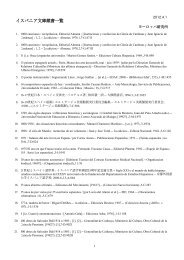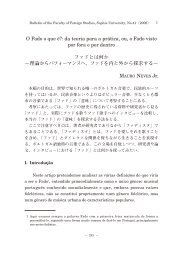Forgotten Paths to NEPA: A Historical Analysis of the Early ...
Forgotten Paths to NEPA: A Historical Analysis of the Early ...
Forgotten Paths to NEPA: A Historical Analysis of the Early ...
You also want an ePaper? Increase the reach of your titles
YUMPU automatically turns print PDFs into web optimized ePapers that Google loves.
<strong>Forgotten</strong> <strong>Paths</strong> <strong>to</strong> <strong>NEPA</strong><br />
“I now teach and write about ppb and manure management. We never<br />
thought thirty seven years ago [in 1970] that we would be involved in an<br />
environmental law that has matured, become hybrid in strategy, be so technical—and<br />
perhaps for many less exciting. Perhaps <strong>the</strong> technical nature <strong>of</strong><br />
domestic law explains in some part <strong>the</strong> growing interest in international<br />
environmental law. . . . I am not an his<strong>to</strong>rian, but I am a relic <strong>of</strong> environmental<br />
law, or put more kindly, a source <strong>of</strong> oral his<strong>to</strong>ry about this law.” 2<br />
I<br />
The purpose <strong>of</strong> this paper is <strong>to</strong> locate <strong>the</strong> emergence <strong>of</strong> environmental law in<br />
<strong>the</strong> United States within <strong>the</strong> his<strong>to</strong>rical context <strong>of</strong> <strong>the</strong> 1960s and beyond. It is<br />
important <strong>to</strong> do so because many believe that federal regulation <strong>of</strong> environmental<br />
quality did not exist prior <strong>to</strong> 1970. “U.S. environmental policy prior <strong>to</strong> 1970<br />
included over seven decades <strong>of</strong> experience in managing <strong>the</strong> environment as a<br />
natural resource base, but almost none in <strong>the</strong> regulation <strong>of</strong> environmental quality,”<br />
leading environmental policy analyst Richard Andrews points out. “Federal<br />
management <strong>of</strong> public lands and waters was well established, as was <strong>the</strong> federal<br />
role in funding major public infrastructure. . . . In contrast, federal authority <strong>to</strong><br />
protect public health, safety, and environmental quality was limited.” 3<br />
This paper will first set <strong>the</strong> his<strong>to</strong>rical context <strong>of</strong> post-WWII American society,<br />
and secondly sort out <strong>the</strong> legal fac<strong>to</strong>rs by examining how law pr<strong>of</strong>essors have<br />
discussed <strong>the</strong> his<strong>to</strong>rical emergence <strong>of</strong> environmental laws. After trying <strong>to</strong> relate<br />
<strong>the</strong> legal fac<strong>to</strong>rs with o<strong>the</strong>r broader socio-cultural fac<strong>to</strong>rs, <strong>the</strong> paper will conclude<br />
that various environment-related events, issues, and fac<strong>to</strong>rs in <strong>the</strong> 1960s contributed<br />
<strong>to</strong> <strong>the</strong> birth <strong>of</strong> environmental law. Indeed, <strong>the</strong>re is a long-standing journalistic<br />
tendency <strong>to</strong> locate environmentalism’s beginning with <strong>the</strong> publication <strong>of</strong> Silent<br />
Spring and with Earth Day but <strong>to</strong> see nothing between 1962 and 1970. Although<br />
a limited number <strong>of</strong> works counter this tendency stressing its longer term roots,<br />
<strong>the</strong>y fail <strong>to</strong> examine <strong>the</strong> relationship between socio-cultural events in <strong>the</strong> 1960s<br />
and <strong>the</strong> early emergence <strong>of</strong> environmental law.<br />
20


